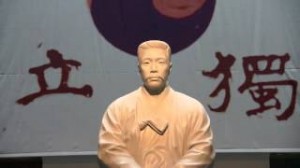Special to WorldTribune.com
By Donald Kirk, East-Asia-Intel.com
Nowhere does the phrase, “One man’s terrorist is another man’s freedom fighter,” apply more precisely than to Ahn Jung-Geun.
Whether you call him a “terrorist,” as do the Japanese, or a heroic Korean revolutionary, as he is viewed in Korea and China, Ahn goes down in history for having assassinated Hirobumi Ito, the first Japanese governor-general of Korea, in Harbin in 1909.

Ahn fired the shots that killed Ito as he was about to meet a ranking Russian official on a railroad platform to negotiate relations in the aftermath of two devastating wars — first the Japanese defeat of the Chinese in 1895 and then their defeat of the Russians in 1905.
In both these wars, control over the Korean peninsula had been at the core of the fighting. Japan quickly spread its writ over the Korean Peninsula, caught in the vortex of a much larger regional struggle.
Ito, who had been prime minister of Japan during a period of modernization in the late 19th century, preferred improved relations with Russia, which had greeted him with an honor guard in Harbin, a prospering Russian city in Manchuria.
Now, more than a century after Ito’s death, the Chinese are honoring Ahn with a memorial hall where Ahn killed Ito — an act that China views as vengeance for Japan’s rule over much of Northeast Asia. In Seoul, the memory of Ahn lives on in another memorial on the slopes of Namsan near the Namsan Library.
The Japanese, as might be expected, don’t see the assassination as do the Chinese and Koreans. Japanese officials have labeled Ahn a “criminal” and a “terrorist”; they fail to see why China would honor the man responsible for the death of one of Japan’s most venerated figures.
Ito as prime minister had been at the forefront of sweeping reforms that propelled Japan from a feudal society to a modern nation-state after the restoration of imperial rule under the Emperor Meiji in 1868.
The Japanese, however, had been living in isolation for so long that they failed to comprehend the limits of their power as they expanded commercially and militarily over Korea and China.
As the first governor-general after the Joseon Kingdom became a Japanese “protectorate” in 1905, Ito saw the Joseon Dynasty heritage as an obstacle.
Enforcing Japan’s takeover of the Korean economy, education and governance, he got King Gojong to resign and maneuvered Korea into acquiescence to Japanese administration.
Ito was not, however, a military man. He faced criticism from militarists who were more extreme than he, and he was no longer governor-general when he made his fateful journey to Harbin.
So what are we to make of Ahn and his legacy? Ahn lives on today as a legendary figure whose signature deed symbolizes Korean and Chinese protests against what they see as suffering inflicted by the Japanese.
His place in history seems all the more relevant in the aftermath of Japanese Prime Minister Shinzo Abe’s visit to the Yasukuni shrine honoring several million Japanese who died in foreign wars.
It is impossible to forget the memorial specifically honors several hundred adjudged to have been “war criminals,” including their war-time leader, Hideki Tojo.
Nor does Japan show signs of compromising with South Korea, even for the sake of shared concern about North Korea, on such issues as textbook revisions, compensation for comfort women or, for that matter, Dokdo, which the Japanese call Takeshima and claim in the face of Korean control of those barren rocks.
The Japanese see memorials to Ahn as an affront but seem oblivious to their real meaning as tensions rise between Japan and China. Korea, now as more than a century ago, is caught in between these external forces.
The act of assassination, though, raises other questions. Ahn was hanged six months before Korea’s annexation by Japan in August 1910 brought a complete end to Korean sovereignty.
One wonders if the assassination led to annexation, which Ito had opposed, and to much harsher restraints imposed by Japan before, during and after the revolution of March 1, 1919.
More specifically, what might Ahn have done if he had given up on assassinating the man who stood for all that he hated? Ahn’s writing remains a matter of historical study.
Scholars have turned up details of his revolutionary activities. At the age of 30, Ahn had a life ahead of him as a firebrand who might have done so much more to battle Japanese rule.
He might not have brought about Korean independence, but he might have molded a movement with far more strength than the disparate forces that rose up against Japan over the next 35 years before Korea’s liberation — not in revolution but in Japan’s defeat in World War II.
Columnist Donald Kirk has been covering events in Northeast Asia since the 1970s. He’s at kirkdon@yahoo.com.

You must be logged in to post a comment Login